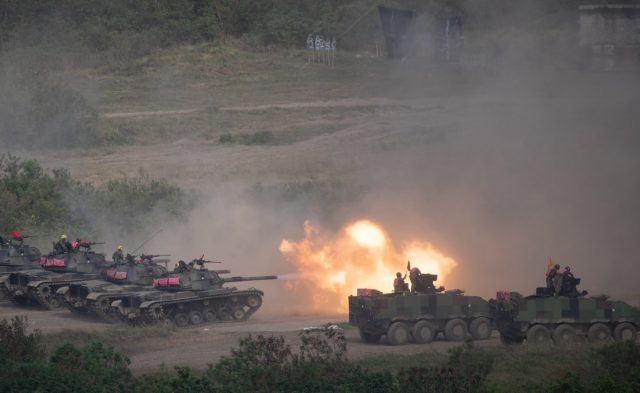While taking heavy losses, Taiwan would be able to defend against a Chinese invasion, a wargaming simulation ran by the Center for Strategic and International Studies (CSIS) shows.
The think tank developed a wargame for a Chinese amphibious invasion of Taiwan and ran it 24 times. In most scenarios, the United States/Taiwan/Japan defeated a conventional amphibious invasion by China and maintained an autonomous Taiwan.
CSIS notes that the simulation left the United States with two lost aircraft carriers over four weeks of fighting, as well as hundreds of aircraft, and up to two dozen other ships. Japan would also be dragged into the conflict, with its bases coming under attack, the simulation showed.
“Taiwan saw its economy devastated. Further, the high losses damaged the US global position for many years. China also lost heavily, and failure to occupy Taiwan might destabilize Chinese Communist Party rule. Victory is therefore not enough. The United States needs to strengthen deterrence immediately,” CSIS wrote in a report on the wargame that can be read in full here.
The wargames were organized in five types of scenarios: base scenarios, pessimistic scenarios, optimistic scenarios, the “Taiwan stands alone” scenario, and “Ragnarok” scenarios. The latter four examined the impact of adjusting critical assumptions from their most likely base case to less likely excursion cases.
In the base scenarios, two out of three of these iterations were decided quickly, with the Chinese forces ashore unable to capture major cities and out of supplies within 10 days. In one iteration, PLA forces landed in the south and captured the port at Tainan. However, US air strikes prevented its use, and the Chinese position was untenable by D plus 21. This was the only iteration of the base scenario
that was not judged to be a decisive Chinese defeat.
In all iterations of the base scenario, US Navy losses included two US aircraft carriers as well as between 7 and 20 other major surface warships (e.g., destroyers and cruisers). These losses were partly an artifact of US forward deployment aimed at deterring China, as the scenario begins with two carriers and an additional SAG positioned in vulnerable positions off Okinawa. It also reflects the vulnerability of surface ships to large salvos of modern anti-ship missiles. These salvos exhausted the ships’ magazines of interceptors; even with the base case assumption that shipborne missile defense works very well, there are simply too many attacking missiles to intercept.
The JMSDF suffered even more heavily, as all its assets fall within the range of Chinese anti-ship missile systems, which include anti-ship ballistic missiles and long-range ASCMs as well as submarines and shorter-range munitions.
China’s losses in the base scenario were also high. In all iterations, PLAN ships around Taiwan were the primary focus of attack, and China’s naval losses averaged 138 major ships in the three iterations of the base scenario. On average, these included 86 amphibious ships (90 percent of the total) and 52 other major surface warships.244 Chinese aircraft losses, averaging 161 fixed-wing combat aircraft per iteration, were smaller than those for the United States. But in the base iterations, the United States never attacked Chinese bases (though they were permitted to do so according to the scenario assumptions), so all of China’s air losses were suffered in the air. Therefore, China would have lost many aircrews but had no losses to ground crews.
According to the think tank, four conditions need to be met to defeat a Chinese invasion.
The first is that Taiwanese forces must hold the line, which means the island would have to strengthen its ground forces. Because some Chinese forces will always land on the island, Taiwanese ground forces must be able to contain any beachhead and then counterattack forcefully as Chinese logistics weaken. However, CSIS says the Taiwanese ground forces have severe weaknesses. Therefore, Taiwan must fill its ranks and conduct rigorous, combined arms training. Ground forces must become the center of Taiwan’s defense effort.
The second condition is that there is no “Ukraine model” for Taiwan. In the Ukrainian scenario, the United States and the North Atlantic Treaty Organization (NATO) have not sent troops directly into combat but have sent massive amounts of equipment and supplies to Ukraine, with Russia unable to interdict this overland flow.
However, the “Ukraine model” cannot be replicated in Taiwan because China can isolate the island for weeks or even months. Taiwan must start the war with everything it needs. Further, delays and half measures by the United States would make the defense harder, increase US casualties, allow China to create a stronger lodgment, and raise the risk of escalation, CSIS argues.
The third condition is for the United States to be able to use its bases in Japan for combat operations. This is why CSIS recommends the US should deepen diplomatic and military ties with Japan. While other allies (e.g., Australia and South Korea) are important in the broader competition with China and may play some role in the defense of Taiwan, Japan is the linchpin. Without the use of US bases in Japan, US fighter/attack aircraft cannot effectively participate in the war.
Finally, a successful defense of Taiwan is contingent on the United States being able to strike the Chinese fleet rapidly and en masse from outside the Chinese defensive zone. This is why the think tank recommended an increase in the arsenal of long-range anti-ship cruise missiles. Bombers capable of launching standoff, anti-ship ordnance offer the fastest way to defeat the invasion with the least amount of US losses. Procuring such missiles and upgrading existing missiles with this anti-ship capability needs to be the top procurement priority, CSIS said in the report.



























